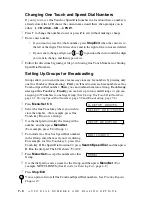
7 - 5
A U T O D I A L N U M B E R S A N D D I A L I N G O P T I O N S
Speed Dialing
1
Pick up the handset—
OR
—Press
Hook
. (See
Storing Speed Dial Numbers
, page 7-
2.)
2
When you hear a dial tone, press
Search/Speed Dial
, press
#
, and then press the
two-digit Speed Dial number.
3
If you pressed
Hook
to dial the call, pick up the handset when the other party answers.
(The speaker works only one way; the other party won’t be able to hear you unless you
pick up the handset.)
4
To hang up a voice call, replace the handset.
Dialing Access Codes and Credit Card Numbers
Sometimes you may want to choose from among several long distance carriers when
you make a call. Rates may vary depending upon the time and destination. To take
advantage of low rates, you can store the access codes or long-distance carriers as One
Touch and Speed Dial numbers. You can store these long dialing sequences by
dividing them and setting them up separately in any combination. You can even
include manual dialing using the dial pad. The combined number will be dialed in the
order you enter it, as soon as you press
Fax Start
. Make sure you select CHAIN as
the type of the number when you store it as a One Touch or Speed Dial. (See
Storing
One Touch Dial Numbers and Storing Speed Dial Numbers
, page 7-1 to 7-2.)
For example:
You store “555”on One Touch key
3
and “7000”on One Touch key
4
. If you press One
Touch
3
,
4
and
Fax Start
you will dial “555-7000”. To temporarily change a
number, you can substitute part of the number with manual dialing using the dial pad.
For example, to change the number to 555-7001 you can press One Touch
3
, and then
press
7
,
0
,
0
,
1
using the dial pad.
If you are sending a fax, press
Fax Start
after entering the Speed Dial number. If you
picked up the handset, press
Fax Start
when the receiving fax machine answers with
fax tones.
(For USA Only) The CallManage access code can save you money on long distance
calls (for details, see
CallManage,
page
8-6
).
Pause after dialing Speed Dial numbers for the name to be displayed before you enter
the next portion of the dialing sequence.
















































